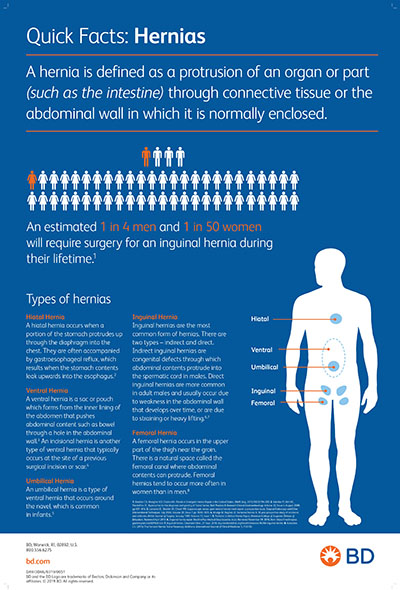Did you know that nearly 5 million people are diagnosed with a hernia each year, but only about 700,000 (or 14 percent) have them surgically repaired1? At BD, we are dedicated to improving patient outcomes for chronic conditions, including hernias. As part of Hernia Awareness month, we are sharing basic facts about hernias and highlighting some of the technological innovations and methodologies that are advancing hernia prevention and care today.
What is a hernia?
A hernia is defined as a protrusion of an organ or part (such as the intestine) through connective tissue or the abdominal wall in which it is normally enclosed. There are five main types of hernias: femoral, hiatal, inguinal, umbilical, and ventral.
How do I know if I have a hernia?
In the early stages, you may experience some discomfort or notice a small bulge or protrusion, while more severe cases may be quite painful, cause nausea, vomiting, and obstruction. Either way, hernias can be diagnosed by your healthcare provider via a physical exam. If you suspect that you may have a hernia, it’s best to contact your doctor.
What treatments are available?
Some hernias don’t require medical attention, since they don't cause any symptoms. On the other hand, an estimated 1 in 4 men and 1 in 50 women will require surgery for an inguinal hernia during their lifetime.2
Today, there are many effective surgical options for treating a hernia. Innovations in minimally invasive surgical techniques can allow for less pain, fewer complications, and shorter post-operative recovery times. Laparoscopic repair, which only requires a small incision, is increasingly popular, while a new pathway for robotic hernia repair allows for better visualization and more accurate control over the surgical area. Both of these options can be combined with surgical mesh that has been optimized for robotic and laparoscopic repair. When minimally invasive techniques are less feasible, such as when a previous surgery has caused scar tissue, doctors may opt for a traditional open repair surgery.
Innovations in mesh are enabling new pathways for repair as well. For patients seeking an alternative to permanent mesh, bioresorbable mesh alternatives can work with your body to rebuild your tissue, leaving you with a strong repair and no foreign material left behind. A strong repair can reduce the rate of hernia recurrence.
Additionally, some technologies can assist surgeons during the procedure. One of which is fixation. Fixation systems are uniquely designed for mesh fixation during open or minimally invasive procedures. A key features during fixation includes unique fasteners, which are designed to ensure no sharp points are left behind in the patient.
To learn more about how BD is advancing hernia prevention and repair, visit our patient information webpage.
1 Make the Right Choice for Hernia Treatment. Hernia Treatment and Surgery, Hernia Treatment Guide | Cleveland Clinic, pages. clevelandclinic.org/hernia-index.html.
2 Beadles CA, Meagher AD, Charles AG. Trends in Emergent Hernia Repair in the United States. JAMA Surg. 2015;150(3):194-200.
BD-36726
Subscribe to receive BD blog alerts
